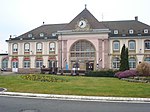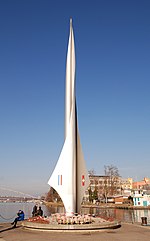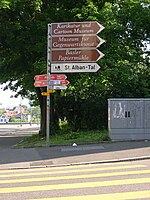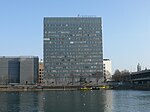In the siege of Hüningen (27 November 1796 – 1 February 1797), the Austrians captured the city from the French. Hüningen is in the present-day Department of Haut-Rhin, France. Its fortress lay approximately 2.5 miles (4.0 km) north of the Swiss city of Basel and .5 miles (0.80 km) north of the spot where the present-day borders of Germany, France and Switzerland meet. During the time of this siege, the village was part of the Canton of Basel City and the fortress lay in area contested between the German states and the First French Republic.
The siege occurred within the French Revolutionary Wars during which Revolutionary France ranged itself against a Coalition that included most of the states with which it shared land or water borders. In particular, France was at odds with the European monarchies, who initially feared for the safety of Louis XVI and his wife, who was the sister of the Holy Roman Emperor. Fighting, which began in 1792, had been inconclusive. Fighting in 1795 had largely favored the Coalition; the Campaign in the Rhineland in 1796, though, had pushed the Coalition forces far into the German states; the Coalition forces had pushed back and, at the end of the summer's fighting in 1796, the Austrian force under command of Archduke Charles had succeeded in pushing the French back to the Rhine.
With the conclusion of the Battle of Schliengen on 24 October, the French army withdrew south and west toward the Rhine. Forces commanded by Jean Charles Abbatucci and Pierre Marie Barthélemy Ferino provided the rear guard support and the main force retreated across the Rhine into France. The French retained control of the fortifications at Kehl and Hüningen and, more importantly, the tête-du-ponts (bridgeheads) of the star-shaped fortresses where the bridges crossed the Rhine. The French chief commander, Jean Victor Moreau, offered an armistice to the Austrian commander, which the archduke was inclined to accept. He wanted to secure the Rhine crossings and then send troops to northern Italy to relieve Dagobert Sigmund von Wurmser at besieged Mantua; an armistice with Moreau would allow him to do that. However, his brother, Francis II, the Holy Roman Emperor, and the civilian military advisers of the Aulic Council categorically refused such an armistice, forcing Charles to order simultaneous sieges at Kehl and Hüningen. These tied his army to the Rhine for most of the winter. He himself moved north with the bulk of his force to invest the larger crossing at Kehl, and instructed Karl Aloys zu Fürstenberg to conduct the siege in the south by Basel. While the Austrians besieged these Rhine crossings, Moreau had sufficient surplus troops to send 14 demi-brigades (approximately 12,000 troops) into Italy to assist in the siege at Mantua.Fürstenberg's force initiated the siege within days of the Austrian victory at the Battle of Schliengen. Most of the siege ran concurrently with the siege at Kehl, which concluded on 9 January 1797. By the time troops engaged at Kehl marched to Hüningen in preparation for a major assault, Fürstenberg had established extensive earthworks, built three large batteries that rained continuous cannonades into the fortress. The Habsburgs repelled a French sortie in early December in which Abbatucci, the French commander, was killed. His replacement, Georges Joseph Dufour, capitulated on 1 February 1797, preventing a costly assault, and the French evacuated, taking everything of value that remained with them. Like the conclusion of the siege at Hüningen, the Austrians took possession of a pile of rubble.











